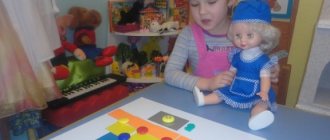Presentation for senior preschool age. (The world around us. Speech development) Pets.
#Educational and methodological materials #Presentation #Educator #Speech therapist #Preschool education
Pets Senior preschool age Goal: - Consolidate children's ideas about pets Tasks: Clarify and expand children's ideas about pets - appearance, who they live with, what benefits they bring, what they eat, how a person cares for animals; Clarify and expand the vocabulary on the topic: “Pets” (sneak, lap, meow, scratch, purr, lick, transport (people and cargo), graze, give (milk and meat), run, walk); Develop word formation skills; Continue to develop logical thinking, attention, memory, auditory and visual perception.
The dog eats meat and loves to chew bones. The dog lives in a kennel. Her cub is called a pup(s). A dog guards a person's home. The dog eats meat and loves to chew bones. The dog lives in a kennel. Her cub is called a pup(s). A dog guards a person's home. What can a dog do? Biting, running, walking, sitting, sleeping, eating, moving ears, wagging tail. The dog barks.
The cat eats mice and dairy products. The cat lives in a house near people. Her cub is called a kitten(s). A cat catches mice - this is how it helps a person. What can a cat do? Catching mice, purring, lapping milk, sneaking up, running, sleeping. The cat meows.
In summer it feeds on grass, and in winter on hay. The cow lives in a barn. Her baby is called a calf (calf). The cow gives man milk and meat. The cow moos.
The horse eats grass, hay, oats. The horse lives in a stable. Her young are called a foal(s). The horse carries a load. The horse neighs.
The pig eats vegetables, apples, grass. The pig lives in a pigsty. Her baby is called a piglet (piglets). A pig gives meat to a man. The pig grunts.
The rabbit eats carrots and cabbage. Lives in a cage. Its baby is called a baby rabbit. The rabbit gives meat.
The sheep eats grass and hay. A sheep lives in a sheepfold. Her baby is called a lamb(s). A sheep gives a person wool (yarn is made from wool, warm clothes are knitted from yarn. A sheep bleats.
The goat eats grass and cabbage. The goat lives in a barn, in a stable. Her baby is called a kid (goat). A goat gives a person milk and wool. The goat bleats.
Why are these animals called pets? (because they live next to a person, and the person takes care of them) Why are these animals called pets? (because they live next to a person, and the person takes care of them) Emerald eyes, Downy fur coat, Dear songs, Iron claws. (Cat.) What do we know about him? Guards the master's house, Now growls, now barks, Now wags its tail. (Dog) In front - a snout, in the back - a hook, in the middle - a back, on the back - a bristle. (Pig) I’ll help you guess who is grazing in the meadow. To keep us healthy, They give us milk... (Cows) Curls on the horns, And rings on the sides. He went out to eat some daisies. What's his name? (Lamb) With a beard, not an old man, With horns, not a bull, Milked, not a cow, Pulls its bast, But does not weave bast shoes. (Goat) He likes to eat carrots and cabbage for dexterity, And he watches Tolik’s cage, A fluffy one lives there... (Rabbit) A champion in fast running, I sometimes drive carts. Uncle groom brought me water, hay and oats. (Horse) Riddles
“The fourth odd one” “The fourth odd one” The game develops attention, thinking, logic, intelligence and speech. We need to explain WHY the animal is superfluous!!! Fox is a wild animal Chicken is a bird, not an animal
Foal - young, other adults Rabbit - no hooves.
Presentation on the topic: “Amazing animals living in Russia”
Amazing animals that live in Russia
Red Wolf
A very rare canine species that is endangered. Outwardly it looks like a cross between a wolf, a fox and a jackal. Red wolves differ from ordinary wolves primarily in their coloring, fluffier fur and long tail. Red wolves are distributed throughout the entire territory from the Tien Shan to Altai and south to the Malay Archipelago. There is no exact data on the current state of the population, but the red wolf is listed in the Red Book with the status of an endangered species.
Japanese green pigeon
It lives mainly on the Japanese Islands, the Kuril Islands and Primorye. They nest high in the treetops and lead a secretive lifestyle. The Japanese green pigeon is listed in the Red Book of Russia; hunting for this species is prohibited.
Himalayan bear
Males are 120-150 cm long, height at the withers is about 80 cm and weigh about 120-140 kg. Himalayan bears live primarily in mountain forests from Iran through Afghanistan, Pakistan and the Himalayas to Korea and Japan. In the north, the habitat covers the Primorsky and southern regions of the Khabarovsk Territory. The Himalayan bear is a prized game mainly due to the use of its body parts in Chinese folk medicine.
Musk deer
A small artiodactyl deer-like animal. Unlike deer, which the musk deer is sometimes classified as, it does not have antlers. Males have long curved fangs protruding from under the upper lip by 7-9 cm; serve as a tournament weapon. They also have an abdominal gland that produces musk. Musk deer are distributed from the Eastern Himalayas and Tibet to Eastern Siberia, Korea and Sakhalin, inhabiting steep mountain slopes covered with coniferous forest. Musk deer in the Russian Federation is a game species. Officially, based on the results of censuses, it is recognized that the number of musk deer in Russia is 120-125 thousand.
Black vulture
This is a resident bird of the mountains and foothills. It lives in Southern Europe, North Africa, Western and Central Asia, where it is relatively numerous, in small numbers in the southeastern Altai. Feeds on carrion. In search of food, they cover enormous distances every day - up to 300-400 km, skillfully using rising currents of heated air for soaring flight.
Mandarin duck
The Mandarin duck is a small and very beautiful duck, which is part of the genus of forest ducks, 41-49 cm long and a wingspan of 65-75 cm. The duck has a fairly large head and a long tail. The geographic range of this colorful member of the duck family is in Eastern Siberia, China and Japan, and is a migratory bird. The mandarin duck lives in forests, preferring wooded ponds and fast-flowing rocky streams, where they can swim and eat to their heart's content.
Black stork
It lives in the forest zone of Eurasia, trying to avoid people. In Russia, the black stork inhabits the territory from the Baltic Sea through the Urals and all of Southern Siberia to the Far East. The lifestyle of the black stork has been poorly studied. This secretive bird prefers to settle in dense, old forests on plains and foothills near bodies of water - forest lakes, rivers, swamps. In flight, the black stork, like other storks, often soars with its wings spread out. Like all storks, the black stork flies with its neck stretched forward and its long thin legs thrown back.
Dzeren
This is an ungulate animal of the bovid family. It lives in the steppes and semi-deserts of Mongolia and China (Inner Mongolia, Gansu). On the territory of Russia it is very rare, listed in the Red Book, found in Dauria, in the Chui steppe and the Ubsunur depression when entering from Mongolia. Until the late 1930s, the gazelle was numerous in Tuva, but later the population declined sharply. Currently, gazelle in Russia is constantly found only in the Daursky Nature Reserve and its environs in the south of the Trans-Baikal Territory.
Long-tailed eagle
A species of large migratory birds of prey from the hawk family. Found in Central Asia, between the Caspian Sea and the Yellow Sea, from Kazakhstan and Mongolia to the Himalayan Mountains, Pakistan, India and Bangladesh. Partially migrate; Central Asian and South Asian birds winter in northern India, while western birds winter in the Persian Gulf.
Tarbagan
A mammal of the marmot genus, up to 60 cm long. It lives in Russia (in the steppes of Transbaikalia and Tuva), Mongolia and Northeast China. Black-capped marmots are also called tarbagans in Kamchatka and Koryakia. Is a carrier of the causative agent of plague.




